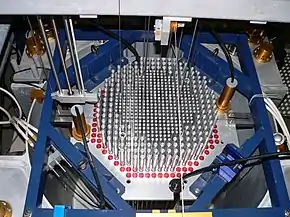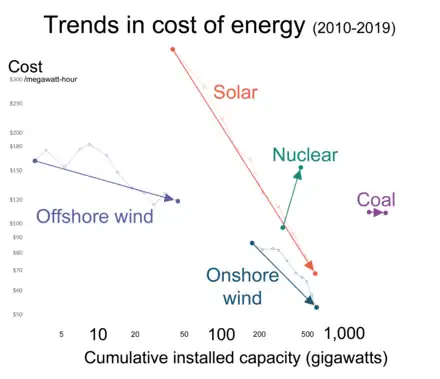Portal:Nuclear technology
The Nuclear Technology Portal
Introduction

- Nuclear technology is technology that involves the nuclear reactions of atomic nuclei. Among the notable nuclear technologies are nuclear reactors, nuclear medicine and nuclear weapons. It is also used, among other things, in smoke detectors and gun sights. (Full article...)
- Nuclear power is the use of nuclear reactions to produce electricity. Nuclear power can be obtained from nuclear fission, nuclear decay and nuclear fusion reactions. Presently, the vast majority of electricity from nuclear power is produced by nuclear fission of uranium and plutonium in nuclear power plants. Nuclear decay processes are used in niche applications such as radioisotope thermoelectric generators in some space probes such as Voyager 2. Generating electricity from fusion power remains the focus of international research. (Full article...)
- A nuclear weapon is an explosive device that derives its destructive force from nuclear reactions, either fission (fission bomb) or a combination of fission and fusion reactions (thermonuclear bomb), producing a nuclear explosion. Both bomb types release large quantities of energy from relatively small amounts of matter. (Full article...)
General images -
Selected article -
The Ames Project was a research and development project that was part of the larger Manhattan Project to build the first atomic bombs during World War II. It was founded by Frank Spedding from Iowa State College in Ames, Iowa as an offshoot of the Metallurgical Laboratory at the University of Chicago devoted to chemistry and metallurgy, but became a separate project in its own right. The Ames Project developed the Ames Process, a method for preparing pure uranium metal that the Manhattan Project needed for its atomic bombs and nuclear reactors. Between 1942 and 1945, it produced over 1,000 short tons (910 t) of uranium metal. It also developed methods of preparing and casting thorium, cerium and beryllium. In October 1945 Iowa State College received the Army-Navy "E" Award for Excellence in Production, an award usually only given to industrial organizations. In 1947 it became the Ames Laboratory, a national laboratory under the Atomic Energy Commission. (Full article...)
Selected picture -

Did you know?
- ... that Helen Steven shared the Gandhi International Peace Award for her opposition to the nuclear submarine base in Scotland?
- ... that coral cores from Flinders Reef capture environmental changes caused by the use of nuclear weapons?
- ... that the village of Pstrąże is known as the "Polish Chernobyl" due to its reputation as a ghost town and a former storage site for nuclear weapons?
- ... that under college president Arthur Bronwell in 1959, Worcester Polytechnic Institute built one of the first nuclear research reactors at an American university?
- ... that after journalist Adele Ferguson's criticism of the U.S. Navy's sex discrimination attracted nationwide attention, she was offered a personal tour of a nuclear submarine?
- ... that Project Carryall proposed the detonation of 23 nuclear devices in California to build a road?
Related WikiProjects
- WikiProject Energy
- WikiProject Technology
- WikiProject Military history
Things you can do
| Parts of this portal (those related to section) need to be updated. Please help update this portal to reflect recent events or newly available information. Relevant discussion may be found on the talk page. (September 2021) |
|
|
Here are some Open Tasks :
|
Selected biography -

At 21, Wheeler earned his doctorate at Johns Hopkins University under the supervision of Karl Herzfeld. He studied under Breit and Bohr on a National Research Council fellowship. In 1939 he collaborated with Bohr on a series of papers using the liquid drop model to explain the mechanism of fission. During World War II, he worked with the Manhattan Project's Metallurgical Laboratory in Chicago, where he helped design nuclear reactors, and then at the Hanford Site in Richland, Washington, where he helped DuPont build them. He returned to Princeton after the war but returned to government service to help design and build the hydrogen bomb in the early 1950s. He and Edward Teller were the main civilian proponents of thermonuclear weapons.
For most of his career, Wheeler was a professor of physics at Princeton University, which he joined in 1938, remaining until 1976. At Princeton he supervised 46 PhD students, more than any other physics professor.
Wheeler left Princeton at the age of 65. He was appointed director of the Center for Theoretical Physics at the University of Texas at Austin in 1976 and remained in the position until 1986, when he retired and became a professor emeritus. (Full article...)
Nuclear technology news
- 25 October 2023 – Russia and weapons of mass destruction
- The Russian Federation Council unanimously approves the State Duma's bill to revoke Russia's membership in the Comprehensive Nuclear-Test-Ban Treaty. (The Guardian)
- 17 October 2023 – Russia and weapons of mass destruction
- The State Duma votes unanimously to revoke Russia's ratification of the Comprehensive Nuclear-Test-Ban Treaty. (AFP via The Moscow Times)
- 16 October 2023 – Japan–Russia relations
- Russia suspends imports of Japanese seafood due to concerns over wastewater discharges from the Fukushima Daiichi Nuclear Plant. (AFP via The Jordan Times)
- 5 October 2023 – Russian invasion of Ukraine
- Russia announces the successful test of the Burevestnik, a nuclear-powered and nuclear-capable cruise missile with a potential range of thousands of miles. (Reuters)
Related portals
Related topics
Subcategories
Associated Wikimedia
The following Wikimedia Foundation sister projects provide more on this subject:
-
 Commons
Commons
Free media repository -
 Wikibooks
Wikibooks
Free textbooks and manuals -
 Wikidata
Wikidata
Free knowledge base -
 Wikinews
Wikinews
Free-content news -
 Wikiquote
Wikiquote
Collection of quotations -
 Wikisource
Wikisource
Free-content library -
 Wikiversity
Wikiversity
Free learning tools -
 Wiktionary
Wiktionary
Dictionary and thesaurus
-
 List of all portalsList of all portals
List of all portalsList of all portals -
 The arts portal
The arts portal -
 Biography portal
Biography portal -
 Current events portal
Current events portal -
 Geography portal
Geography portal -
 History portal
History portal -
 Mathematics portal
Mathematics portal -
 Science portal
Science portal -
 Society portal
Society portal -
 Technology portal
Technology portal -
 Random portalRandom portal
Random portalRandom portal -
 WikiProject PortalsWikiProject Portals
WikiProject PortalsWikiProject Portals




.svg.png.webp)

-LLNL.jpg.webp)
























.jpg.webp)
.jpg.webp)



.jpg.webp)






.jpg.webp)





















.jpg.webp)









_conducts_a_fueling_at_sea_(FAS)_with_the_Nimitz-class_aircraft_carrier_USS_George_Washington_(CVN_73).jpg.webp)


